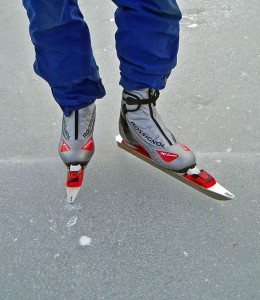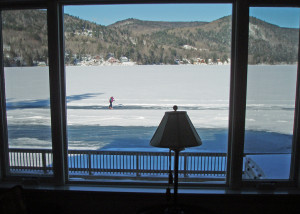
Why Nordic Skating?: You Can’t Control The Weather!
Imagine, if every time you wanted to go cross-country skiing for example, you could order fresh snow, clear sunny (or moonlit) skies, moderate temperatures and no wind.
Sorry, doesn’t work that way. You have to have contingency plans: like being prepared for less-than-perfect weather. (Think: shell garments. . . ) Or, choose something else active and outdoors if you can’t do what you want.
Weather is fickle, especially here in the Northeast. That’s just a fact of life. Some winters, many Active Outdoors enthusiasts, myself among them, will spend a lot of time grumbling about the general lack of snowcover. We want to be cross-country skiing, snowshoeing and backcountry skiing; instead we go hiking on icy trails, Telemarking on groomed ski slopes covered with man-made snow.
What everyone should be doing when there’s cold but no snow is Nordic skating. The worst weather for skiing and snowshoeing—midwinter rains and hard freezes—create absolutely perfect Nordic skating conditions.
Trouble is, most people haven’t discovered Nordic skating. I didn’t find out about until quite recently, and I hate to think of how many opportunities to enjoy ice I’ve missed. I won’t make the same mistake again. Neither should you.

Nordic skating is exactly like Nordic skate skiing except you use long-bladed ice skates instead of short, skinny skis. You can even use the same boots. Of course in skating, unlike skiing, you never have to climb any hills or negotiate your way back down them
The lightest Nordic skates attach to cross-country ski boots designed for skating skis. But if you don’t have skate boots, they have skates that work with hiking or Telemark ski boots. In any case, you have more ankle support than with hockey or figure skates, and your feet stay warmer
Nordic skates seem easier to use and safer than hockey or figure skates. You don’t seem inclined to fall over backwards as easily; your ankles don’t wobble as much.
Nordic skates glide easily and smoothly over rough ice, so you can skate on big lakes and rivers. Nordic skates are designed glide much farther with each push than conventional skates, which means you can travel great distances with less effort.
Unless the wind is blowing . . . Here’s a tip: skate upwind to start. You definitely don’t want to skate downwind thinking “this is easy” only to have to turn around and fight the wind all the way back.

Not surprisingly, Nordic skating got its start in Scandinavia, where gas is over $8 a gallon and human-powered winter sports are a way of life. It’s now popular in parts of Canada, and the upper midwest. But it’s just getting started in the northeast where the hotbed of activity is the upper Connecticut River Valley and the big lakes of northern Vermont and central New Hampshire.
Jamie Hess is the driving force behind this growing sport, at least here in the northeast. His shop, Nordic Skater in Norwich, Vermont is a one-stop resource for the skates, safety gear and protective gear.
If you are interested in trying Nordic skating, Hess demos at a number of events throughout the winter. These give people a chance to get on Nordic skates, free—go to www.nordicskating.org for a list.

The Lake Morey Resort, in Fairlee, Vermont, which is right on the longest plowed ice skating trail in the US has winter packages that will let you try out Nordic skating.
If you’re dreaming of snow, and get ice instead, just adjust and go Nordic skating.


